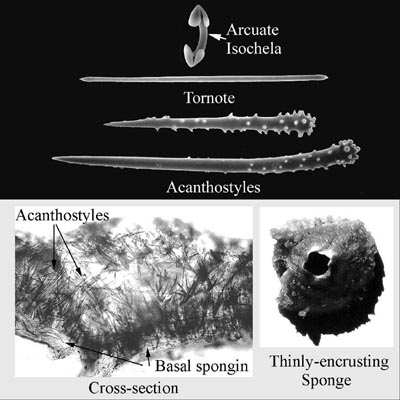[A]
Acanthostyles to 380 μm.
Acanthostyles of 2 size classes. |

| | Hymedesmia (Hymedesmia) sp. A
Hartman, 1975 |
Sponge:
Encrusting to 1.5 mm thick.
Color: Alive: Salmon, salmon-orange, red, burnt sienna, pale terra cotta.
Spicules: Megascleres:
(1) Acanthostyles:
72 -80-90- 112 um.
x 6.5 - 7.0 um.
(2) Acanthostyles:
120 -169-220- 376 um.
x 8.0 - 8.5 um.
(3) Tornotes- Subtylotes:
121 -137-158- 180 um.
x 3.5 um.
Microscleres:
(1) Arcuate Isochelae:
15 -19-23- 30 um.
Skeleton:
Acanthostyles standing erect with heads embedded in basal spongin or forming short tracts to the surface.
Distribution: Central California.
Depth: Intertidal to subtidal.
|
|
[B]
Acanthostyles to 400 μm or greater.
Acanthostyles of 1 size class.
|

| | ?Phorbas. sp. A
Klontz, 1989 |
Sponge:
Thinly encrusting to 1-2 mm.
Color: Alive: Bright red.
Spicules: Megascleres:
(1) Acanthostyles:
48 -177-245- 472 um.
(2)Tornotes:
101 -134-154- 176 um.
Microscleres:
(1)Arcuate Isochelae:
13 -17-20- 24 um.
Skeleton:
Ectosome: Tornotes lying parallel or perpendicular within dermal membrane.
Choanosome: Echinating, branching tracts of Acanthostyles. Those at the base of the tracts have heads embedded in the basal layer of spongin. Tracts more or less erect and do not penetrate dermal membrane.
Distribution: Central California,. Farallon Islands.
Depth: Intertidal.
Note: Was originally described as "new genus, new species A." It could be either Phorbas or Hymedesmia or a new genus. The Systema notes that there are many examples where species may show combinations of characteristics of these two genera. This species needs further examination.
|
|